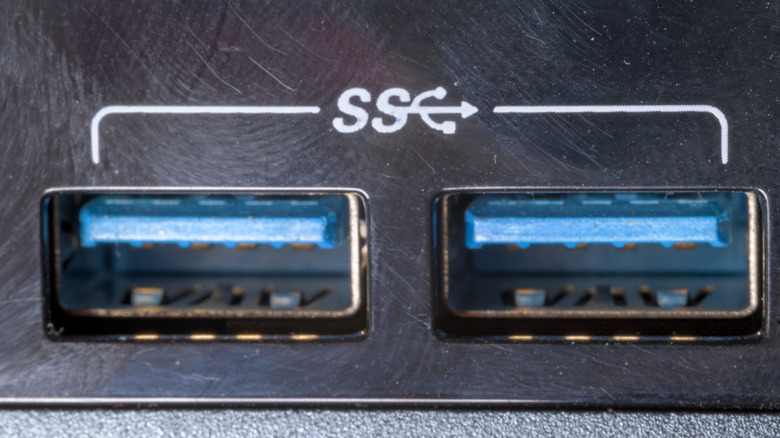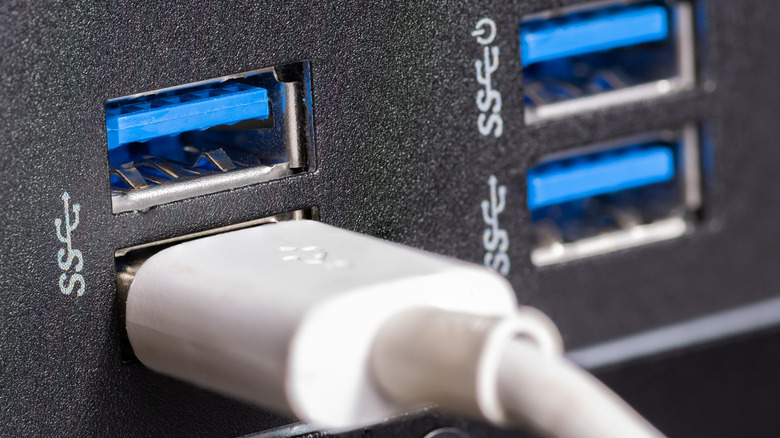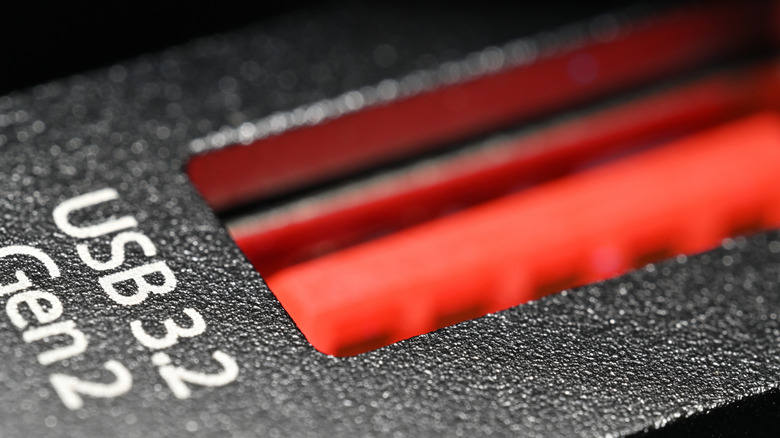What Is An SS USB Port, And What Are They Used For?
If you've ever looked closely at the USB ports on your laptop or desktop PC, you may have noticed that some are labeled with a small symbol. It looks like the letters SS, with a three-pronged icon protruding from it. That trident-shaped icon is the symbol for USB, and the two letters stand for SuperSpeed. Altogether, this indicates that the port has USB SuperSpeed capabilities. In other words, it's the same thing as a blue USB port. Or possibly a red USB port. Things quickly get tricky to explain.
The SuperSpeed designation means a port uses USB 3.2, previously known as USB 3.0. However, SuperSpeed is no longer the fastest type of USB port — that crown is now held by the latest USB4 specification. USB4 is still relatively new, so an average computer is still more likely to have some version of USB 3.x. Over the years, there have been many revisions from USB 3.0 to USB 3.2, all of which were considered SuperSpeed. Still following? Good, because the situation gets even more complex.
SuperSpeed branding was initially created to make it easy for consumers to understand what kind of USB port a product was equipped with. However, companies rarely used that branding in practice. Meanwhile, USB ports continued to be renamed as new versions came out, creating a bizarre state of affairs in which a product labeled as having a USB 3.2 port can be slower than a product claiming to have a USB 3.1 port. Eventually, the SuperSpeed branding was discontinued. So, here's what SuperSpeed USB means on your computer, as well as what eventually replaced it.
SS stands for SuperSpeed USB, the marketing term for USB 3.2
USB naming schemes are created by the USB Implementers Forum (USB-IF), a consortium of tech companies that oversee the development and implementation of USB standards. The SuperSpeed designation was given to the USB 3.0 standard, first announced in 2008, capable of reaching data transfer speeds of 5 gigabits per second (Gbps). Simple enough, right? Unfortunately, it didn't stay that way for long.
After the initial release of USB 3.0 came a slew of upgrades, starting with the introduction of 10Gbps transfer speeds in 2013. Rather than the expected USB 3.1, this was called USB 3.1 Gen 2, while the original USB 3.0 was renamed to USB 3.1 Gen 1. This process was repeated when 20Gbps speeds were introduced with USB 3.2 in 2017. Now, the original 5Gbps standard is called USB 3.2 Gen 1, while the 10Gbps variant is USB 3.2 Gen 2. But the 20Gbps version is not "Gen 3." Instead, because it uses two 10Gbps data lanes to achieve a total of 20Gbps, it's called USB 3.2 Gen 2x2 and only works with USB-C.
None of these names was supposed to matter to consumers. The USB-IF wanted companies to label their products as SuperSpeed, SuperSpeed 10Gbps, and SuperSpeed 20Gbps. Users wouldn't need to worry about the difference between 3.2 Gen 2x1 and Gen 2x2. Instead, they'd only need to look for the SuperSpeed label. But in order to license USB-IF logos, including SuperSpeed branding, products must pass compliance testing. Many companies use their own branding instead, or they simply list the USB version number on product spec sheets, which can mislead consumers who haven't taken the time to understand this confusing system.
SuperSpeed is dead; long live USB Certified
After introducing so much confusion into the market with its USB 3.x naming schemes, the USB-IF phased out the SuperSpeed branding in late 2022. The goal was to cut through the Gordian knot and make things as simple as possible for consumers. After all, the average person can't be expected to figure out what USB 3.2 Gen 2x2 actually means, and even the SuperSpeed branding is somewhat opaque. The new system even does away with USB4 as a consumer-facing brand name.
Under the new naming convention, certified products are labeled to clearly communicate their top speeds. Instead of SuperSpeed, USB 3.2 Gen 1 should now be called USB 5Gbps. There are no more curveballs: USB 10Gbps and USB 20Gbps represent the rest of the USB 3.2 lineup, while USB 40Gbps and USB 80Gbps are used to represent the newer USB4 specifications. Finally, order has been imposed on a world of chaos.
But before you breathe a sigh of tranquil relief, this simplified branding has the same Achilles heel that doomed SuperSpeed. Products must pass USB-IF certification before they can use the new logos. Since USB is an open standard, certification is not required, and the new branding is therefore unlikely to be much more widespread than SuperSpeed was. The upside is that the branding is self-explanatory when companies do license it. Consumers who saw a SuperSpeed port in the wild were likely to be confused by it, leading them to articles like this, whereas a port labeled "USB 5Gbps" is much more upfront.


